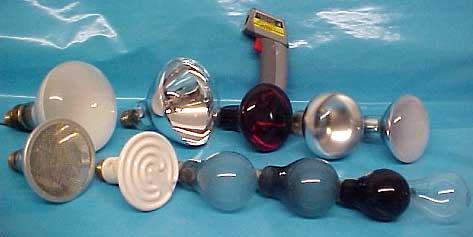
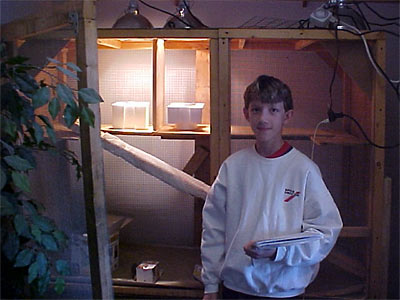
Watts, Heat and Light : Measuring The Heat Output of Different Lamps
This experiment was intended to measure the way in which different “types” of lamps of the same wattage produce drastically different basking temperatures.
Introduction
One of the basic laws of physics is the law of the Conservation of Energy. This simply states that energy cannot be created or destroyed, it can only be transferred from one form to another. So when a 100watt lamp is switched on, 100 watts of electrical energy is converted to 100watts of light and heat; a 50watt lamp produces a total 50 watts of light and heat, and so on.* However, some lamps are more efficient at producing light than others; this determines how much of that 100 watts is transformed into light, and how much is "wasted" and comes out as heat (very useful, though, if what we want is a basking lamp).
An incandescent lamp is an extremely inefficient light source. According to the Wikipedia online encyclopaedia, a 100 watt bulb is 2.1% efficient. In other words, it produces about 2 watts of light and 98 watts of heat.
A halogen lamp is a bit better. For every 100 watts you put in, you get about 3.5 watts of light and 96.5 watts of heat.
Fluorescent lamps are said to be about 8.2% efficient, and although there were no figures on Wikipedia for mercury vapour lamps, I found one reference saying they were about as efficient as fluorescent lamps, and another that said they were three times as efficient as incandescent lamps... so we're looking at 6 - 8% efficiency here. 100 watts of electricity will be converted to, at most 8 watts of light (including UV light) and 92% will still come out as heat.
So the main factors which determine how much heat a lamp puts out, are what type of lamp it is, and its wattage.
However, the heat and light from a lamp can be emitted in all directions, or focused on a small area (consider the heat and light you might experience sitting 2ft below a 60 watt frosted "globe" lamp as opposed to a 60 watt narrow beam spot lamp) hence the shape of the lamp, the type of glass surface and the presence or absence of reflectors, such are found inside spot lamps, will also play a major part in determining how hot a basking spot gets directly under any lamp, of whatever wattage.
 |
 |
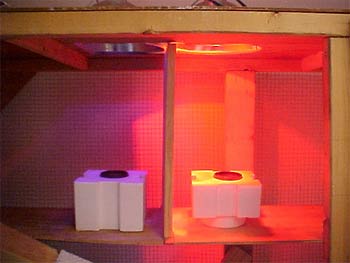 The Experiment.
The Experiment.
In this experiment we used a “heat collector” that consisted of a small metal disc painted flat black. This is the most efficient form of material to absorb the light and heat energy. This was placed on top of a white styrofoam block that would not absorb much heat. This was positioned at 12” (30cm) from the light source.
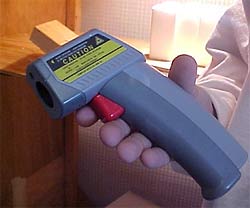 We collected data at 2, 5 and
10 minutes using an infra-red "temperature gun". We also took temperature readings
at the base of the fixture to see how much heat energy was being lost out the
back of the lamps. The fixtures were allowed to cool before the next set of
readings were recorded.
We collected data at 2, 5 and
10 minutes using an infra-red "temperature gun". We also took temperature readings
at the base of the fixture to see how much heat energy was being lost out the
back of the lamps. The fixtures were allowed to cool before the next set of
readings were recorded.
Understand that the temperatures reported do not necessarily represent the actual temperatures you may find in your vivarium, produced by the lamps listed, because different materials will reflect and absorb heat at different rates. The small black metal discs we used will absorb heat differently, and give different results, from a light brown basking log, or white sand, or a living reptile body. Living creatures will disperse heat through their body according to mass. Always triple check basking area temperatures before allowing any reptiles to be exposed to new lamps.
Results
| MAKE | WATTS | TYPE of BULB | TEMP (°F) @ 12" | TEMP (°F) of Lamp Fixture | ||||
| 2 min | 5 min | 10 min | 2 min | 5 min | 10min | |||
| ZooMed | 150 | Infra-red Spot | 149 | 159 | 171 | 77 | 80 | 82 |
| ZooMed | 160 | MV Flood 'Powersun' | 96 | 106 | 115 | 85 | 95 | 102 |
| Westron | 160 | MV Flood 'MegaRay SB' | 98 | 112 | 128 | 74 | 77 | 84 |
| ESU | 150 | Incandescent 'Nocturnal BL' | 143 | 164 | 165 | 100 | 118 | 118 |
| ESU | 150 | Incandescent 'Brightlight' | 191 | 209 | 218 | 75 | 77 | 79 |
| ZooMed | 150 | Flood 'Basking Lamp' | 181 | 186 | 195 | 105 | 114 | 123 |
| ZooMed | 100 | MV Flood 'Powersun' | 118 | 131 | 136 | 98 | 116 | 118 |
| T Rex | 100 | MV Spot 'Active UV Heat' | 93 | 114 | 136 | 84 | 102 | 113 |
| ESU | 100 | Incandescent 'Nightlight' | 134 | 150 | 152 | 78 | 80 | 83 |
| ESU | 100 | Incandescent 'Brightlight' | 165 | 188 | 194 | 77 | 79 | 81 |
| ACE | 100 | Halogen Flood | 205 | 226 | 226 | 77 | 82 | 86 |
| ZooMed | 100 | Ceramic Heat Emitter | 101 | 127 | 140 | 75 | 99 | 104 |
| GE | 100 | Halogen Spot Lamp | 158 | 257 | 271 | 75 | 82 | 87 |
| GE | 100 | Halogen Flood Lamp | 128 | 178 | 187 | 74 | 86 | 88 |
| GE | 75 | Incandescent Spot 'Black Light' | 92 | 101 | 103 | 89 | 96 | 97 |
| GE | 60 | Incandescent 'Black Light' | 102 | 109 | 112 | 93 | 94 | 105 |
| GE | 60 | Incandescent Clear Glass | 169 | 176 | 178 | 75 | 81 | 86 |
| Westron | 60 | Inline MV Flood Lamp | 95 | 97 | 103 | 90 | 93 | 98 |
| Westron | 60 | Inline MV Spot Lamp | 130 | 146 | 150 | |||
| Westron | 60 | Heat Emitter | 98 | 112 | 130 | 77 | 79 | 80 |
| GE | 50 | Halogen Spot Lamp | 185 | 193 | 196 | 76 | 85 | 88 |
| GE | 50 | Halogen Flood Lamp | 123 | 138 | 141 | 74 | 78 | 81 |
Additional Experiment
This experiment dramatically demonstrates the difference in heat output between a 60 watt externally ballasted mercury vapour lamp and a 60 watt halogen lamp.
We placed a 60 watt external ballasted mercury vapor lamp and a 60 watt halogen lamp in two separate insulated boxes with a thermometer inside. If both lamps put out roughly the same amount of heat, these two lamps should have effectively raised the temperature in both boxes to the same degree. After 30 minutes, the thermometer in the container with the halogen lamp gave a reading 20°F higher than the other box, (135°F vs 115 °F) and the heat from the halogen lamp had actually warped the plastic!
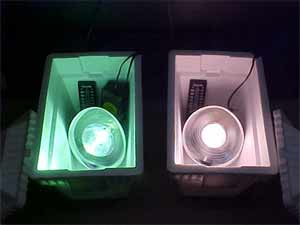 |
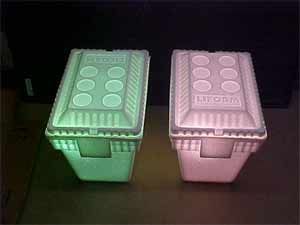 |
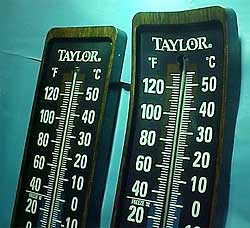 |
Another reason for not using the wattage of a lamp as a guide to its heat output.
Even though we expect the stated wattage on a bulb to be correct, there is always the possibility that it isn’t. We have had several imported mercury vapor lamps tested for wastage and have found that there are some that have been stated as 60 watt yet under investigation were actually 150 watt bulbs. Once again, I can’t express enough the importance of checking basking area temperatures and never relay on the wattage of the lamp to speculate on temperatures they will produce.
Bob MacCargar
January 2006
* well, nothing's as perfect as that.. but that's the general idea.